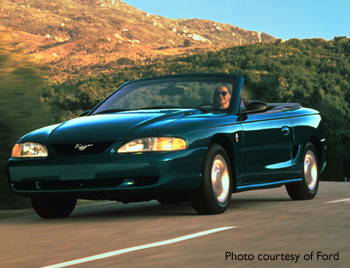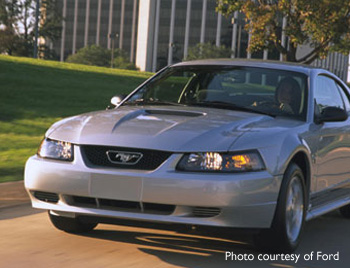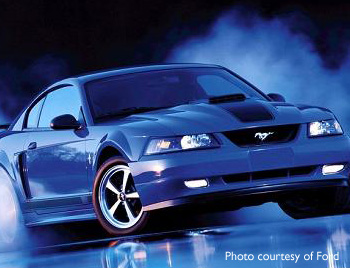Ford Mustang
FOURTH GENERATION FORD MUSTANG: 1994 - 2004
The fourth generation Mustang was produced between the years of 1994 to 2004. Assembled in Dearborn, Michigan, the new Mustang generation had two body styles, the 2-door convertibles and 2-door coupes.
1994 Mustang
1994 marked the 30th anniversary of the Ford Mustang. As such, the Mustang underwent major redesigning. The design, which was code named “SN-95”, was based on an updated version of the Fox platform featuring new stylistic elements made by Patrick Schiavone. However, the 1994 Mustangs dropped the fastback model.
With the SN-95 platform, 1,330 parts of the Mustang were changed out of the 1,850 of its working parts. As such, the 1994 Mustang not only looked different, it also performed differently. Ford wanted the new Mustang to have a stiffer structure. It was offered with two engine options – the 5.0L V8 engine and the 3.8L V6 engine.
In the later part of 1994, Ford introduced the remodeled SVT Mustang Cobra with a 5.0L V8 engine, which produced up to 240 horsepower. It was available in both convertible and couple models, while the hatchback was dropped.
 1995 Mustang
1995 Mustang
For the last time in the history of the Mustang, the 5.0L V8 engine was integrated into the 1995 models of this fabled car. Future models of the Mustang, on the other hand, used a 4.6L engine. During the same year, Ford introduced the stripped-down version of the GT Mustang, which the company called “GTS”. It was equipped with all the performance parts found in the GT, but dropped all flashy accessories such as leather seats, power doors and fog lights.
1996 Mustang
In 1996, Ford released all Mustang Cobras and GTs with a 4.6L modular V8 engine with two valves per cylinder and stopped production for all 5.0L V8 engines. The change was part of Ford’s plan to update its engine lineup. With the Cobra version, a 4.6L dual-overhead cam (DOHC) aluminum V8 engine produced 305 horsepower. GTS Mustangs were still produced, but the name was change to “248A”. The Cobra’s block was aluminum, cross-bolted block. To compensate for the lack of low-end response due to its cylinder heads, the Cobra featured dual runners to make the Mustangs more responsive even at low speeds.
1997 & 1998 Mustang
In 1997, as a defense against car theft that used electronically coded ignition keys, Ford equipped all the Mustangs with Passive Anti-Theft System (PATS) that became a standard feature. In 1998, only a few changes were made to the Mustang. However, the GT model was given a power upgrade, outputting up to 225 horsepower using a modified fuel system, a more aggressive PCM calibration and larger volume exhaust system. A “sports package” with black racing stripes was also introduced.
1 999 Mustang
999 Mustang
In 1999, the round-body Mustang disappeared as the new generation of Mustangs was launched. The overall body style of the 1999 Mustang changed significantly, removing most of the soft lines from the previous model, but the new models were still based on the SN-95 Platform. The new models were designed with sharp lines and aggressive stance, featured a new hood, grille and lamps. Both engines experienced power upgrades – the V6 increasing to 190 horsepower and the V8 producing up to 320 horsepower. The 1999 Mustangs featured a return-less type fuel system that utilizes a PCM-guided fuel rail pressure sensor used in regulating pressure.
2000 Mustang
Ford released the 3rd version of the SVT Mustang Cobra R, but only produced 300 units. It featured a 385 horsepower 5.4L DOHC V8 and the first six-speed manual transmission to be included in a Mustang. However, the production of the Cobra was stopped while Ford was developing new parts for the missing power complaints they received with the 1999 models.
2001 Mustang
In 2001, the changes to the engine were incorporated to achieve ¼-mile times in the low 14/high 13 second range. Also in 2001, the special edition Ford Mustang Bullitt GT was released, selling 6,500 units. It was based on the 1968 Mustang, which Steve McQueen drove in the movie “Bullitt”. The Bullitt Mustang was only offered in Dark Highland Green, Black and True Blue colors with lowered suspension, aluminum gas cap and with a “Bullitt” badge placed on the rear panel. Available as a hardtop, the Bullitt Mustangs were designed to be a “handling-based vehicle”. It received several power upgrades, including a re-designed intake, upgraded exhaust and under-drive pullies, which resulted in a rating of 265 horsepower compared to the standard GT that produced only 260 hp.
2002 Mustang
During this era, SUVs became popular with American automobile industry, so the decline in sports cars was noticeable. While Pontiac Firebird and Chevrolet Camaro both ended production in 2002, the Mustang remained the only sports car that survived the SUV popularity.
 2003 Mustang
2003 Mustang
In 2003, Ford decided to get the Mustang Mach 1 back to the lineup. The new model featured a ram-air “shaker” hood scoop and a V8 engine that produces 305 horsepower. In addition, the SVT Mustang Cobra was released with an Eaton supercharger for its V8 engine that produces up to 390 horsepower – the fastest power produced in Mustang history. For the new Mustang to cope with increased power, the 5-speed Tremec T-45 transmission was replaced by the heavier-duty six-speed Tremec T56. To improve handling, Ford engineers used an independent rear suspension and fitted aggressive tires to achieve 0.90g on skidpad.
The Mach 1 was available in a variety of colors including Black, Azure Blue, Competition Orange, Dark Shadow Grey, Oxford White, Screaming Yellow, Torch Red and Zinc Yellow.
2004 Mustang
In 2004, the Ford Mach 1 3.8L V6 engine was replaced by the 3.9L V6 powerplant, which was found in the Ford Freestar. During 2004, Ford also created its 300 millionth car – the 2004 Mustang GT convertible 40th Anniversary edition. As part of the celebration, Ford released an Anniversary package available for both GT and V6 models, featuring a Crimson red exterior and Arizona Beige Metallic racing stripes placed on the hood.